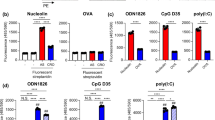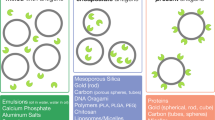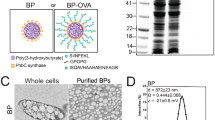Abstract
Dendritic cells (DC) targeting vaccines require high efficiency for uptake, followed by DC activation and maturation. We used magnetic vectors comprising polyethylenimine (PEI)-coated superparamagnetic iron oxide nanoparticles, with hyaluronic acid (HA) of different molecular weights (<10 and 900 kDa) to reduce cytotoxicity and to facilitate endocytosis of particles into DCs via specific surface receptors. DNA encoding Plasmodium yoelii merozoite surface protein 1–19 and a plasmid encoding yellow fluorescent gene were added to the magnetic complexes with various % charge ratios of HA: PEI. The presence of magnetic fields significantly enhanced DC transfection and maturation. Vectors containing a high-molecular-weight HA with 100% charge ratio of HA: PEI yielded a better transfection efficiency than others. This phenomenon was attributed to their longer molecular chains and higher mucoadhesive properties aiding DNA condensation and stability. Insights gained should improve the design of more effective DNA vaccine delivery systems.
This is a preview of subscription content, access via your institution
Access options
Subscribe to this journal
Receive 12 print issues and online access
$259.00 per year
only $21.58 per issue
Buy this article
- Purchase on Springer Link
- Instant access to full article PDF
Prices may be subject to local taxes which are calculated during checkout



Similar content being viewed by others
References
Liu MA . DNA vaccines: an historical perspective and view to the future. Immunol Rev 2011; 239: 62–84.
Seder RA, Hill AVS . Vaccines against intracellular infections requiring cellular immunity. Nature 2000; 406: 793–798.
Park TG, Jeong JH, Kim SW . Current status of polymeric gene delivery systems. Adv Drug Deliv Rev 2006; 58: 467–486.
Liu S, Danquah MK, Ho J, Ma C, Wang L, Coppel R et al. Preparation and characterization of poly(lactic-co-glycolic acid) microparticles containing DNA molecules encoding a malaria vaccine candidate. J Chem Technol Biotechnol 2009; 84: 782–788.
Liu S, Danquah MK, Forde GM, Ma C, Wang L, Coppel R . Microparticle-mediated gene delivery for the enhanced expression of a 19-KDa fragment of merozoite surface protein 1 of Plasmodium falciparum. Biotechnol Prog 2010; 26: 257–262.
Al-Deen FN, Ho J, Selomulya C, Ma C, Coppel R . Superparamagnetic nanoparticles for effective delivery of malaria DNA vaccine. Langmuir 2011; 27: 3703–3712.
Xiang SD, Scalzo-Inguanti K, Minigo G, Park A, Hardy CL, Plebanski M . Promising particle-based vaccines in cancer therapy. Expert Rev Vaccines 2008; 7: 1103–1119.
Hamm A, Krott N, Breibach I, Blindt R, Bosserhoff AK . Efficient transfection method for primary cells. Tissue Engineering 2002; 8: 235–245.
Chapman SWK, Hassa PO, Koch-Schneidemann S, von Rechenberg B, Hofmann-Amtenbrink M, Steitz B et al. Application of pulsed-magnetic field enhances non-viral gene delivery in primary cells from different origins. J Magn Magn Mater 2008; 320: 1517–1527.
Tang RP, Palumbo RN, Nagarajan L, Krogstad E, Wang C . Well-defined block copolymers for gene delivery to dendritic cells: Probing the effect of polycation chain-length. J Control Release 2010; 142: 229–237.
Necas J, Bartosikova L, Brauner P, Kolar J . Hyaluronic acid (hyaluronan): a review. Veterinarni Medicina 2008; 53: 397–411.
Oh EJ, Park K, Kim KS, Kim J, Yang JA, Kong JH et al. Target specific and long-acting delivery of protein, peptide, and nucleotide therapeutics using hyaluronic acid derivatives. J Control Release 2010; 141: 2–12.
Godbey WT, Wu KK, Mikos AG . Poly(ethylenimine) and its role in gene delivery. J Control Release 1999; 60: 149–160.
Al-Deen FN, Selomulya C, Williams T . On designing stable magnetic vectors as carriers for malaria DNA vaccine. Colloids Interfaces B: Biointerfaces 2012; 102: 492–503.
Plank C, Schillinger U, Scherer F, Bergemann C, Remy JS, Krotz F et al. The magnetofection method: Using magnetic force to enhance gene delivery. Biol Chem 2003; 384: 737–747.
Scherer F, Anton M, Schillinger U, Henkel J, Bergemann C, Kruger A et al. Magnetofection: enhancing and targeting gene delivery by magnetic force in vitro and in vivo. Gene Ther 2002; 9: 102–109.
Hartmann G, Weiner GJ, Krieg AM . CpG DNA: A potent signal for growth, activation, and maturation of human dendritic cells. Proc Natl Acad Sci USA 1999; 96: 9305–9310.
Spies B, Hochrein H, Vabulas M, Huster K, Busch DH, Schmitz F et al. Vaccination with plasmid DNA activates dendritic cells via toll-like receptor 9 (TLR9) but functions in TLR9-deficient mice. J Immunol 2003; 171: 5908–5912.
Liao YH, Jones SA, Forbes B, Martin GP, Brown MB . Hyaluronan: pharmaceutical characterization and drug delivery. Drug Delivery 2005; 12: 327–342.
Lim ST, Forbes B, Berry DJ, Martin GP, Brown MB . In vivo evaluation of novel hyaluronan/chitosan microparticulate delivery systems for the nasal delivery of gentamicin in rabbits. Int J Pharm 2002; 231: 73–82.
Laurent TC, Fraser JRE, Pertoft H, Smedsrod B . Binding of hyaluronate and chondroitin sulfate to liver endothelial-cells. Biochem J 1986; 234: 653–658.
Wolny PM, Banerji S, Gounou C, Brisson AR, Day AJ, Jackson DG et al. Analysis of cd44-hyaluronan interactions in an artificial membrane system insights into the distinct binding properties of high and low molecular weight hyaluronan. J Biol Chem 2010; 285: 30170–30180.
Yao J, Fan Y, Du RH, Zhou JP, Lu Y, Wang W et al. Amphoteric hyaluronic acid derivative for targeting gene delivery. Biomaterials 2010; 31: 9357–9365.
Qhattal HSS, Liu XL . Characterization of CD44-mediated cancer cell uptake and intracellular distribution of hyaluronan-grafted liposomes. Mol Pharm 2011; 8: 1233–1246.
Do Y, Nagarkatti PS, Nagarkatti M . Role of CD44 and hyaluronic acid (HA) in activation of alloreactive and antigen-specific T cells by bone marrow-derived dendritic cells. J Immunother 2004; 27: 1–12.
Banchereau J, Steinman RM . Dendritic cells and the control of immunity. Nature 1998; 392: 245–252.
Watts C . Capture and processing of exogenous antigens for presentation on MHC molecules. Ann Rev Immunol 1997; 15: 821–850.
Kim A, Checkla DM, Dehazya P, Chen WL . Characterization of DNA-hyaluronan matrix for sustained gene transfer. J Contro Release 2003; 90: 81–95.
Hamilton JA, Anderson GP . GM-CSF biology. Growth Factors 2004; 22: 225–231.
Ali OA, Mooney DJ . Sustained GM-CSF and PEI condensed pDNA presentation increases the level and duration of gene expression in dendritic cells. J Control Release 2008; 132: 273–278.
Manolova V, Flace A, Bauer M, Schwarz K, Saudan P, Bachmann MF . Nanoparticles target distinct dendritic cell populations according to their size. Eur J Immunol 2008; 38: 1404–1413.
Ito T, Iida-Tanaka N, Niidome T, Kawano T, Kubo K, Yoshikawa K et al. Hyaluronic acid and its derivative as a multi-functional gene expression enhancer: protection from non-specific interactions, adhesion to targeted cells, and transcriptional activation. J Control Release 2006; 112: 382–388.
Culty M, Nguyen HA, Underhill CB . The hyaluronan receptor (cd44) participates in the uptake and degradation of hyaluronan. J Cell Biol 1992; 116: 1055–1062.
Kaya G, Augsburger E, Stamenkovic I, Saurat JH . Decrease in epidermal CD44 expression as a potential mechanism for abnormal hyaluronate accumulation in superficial dermis in lichen sclerosus et atrophicus. J Invest Dermatol 2000; 115: 1054–1058.
Garg HG, Hales CA . Chemistry and Biology of Hyaluronan. Elsevier Ltd.: Oxford, UK, 2004.
Weigel JA, Raymond RC, Weigel PH . The hyaluronan receptor for endocytosis (HARE) is not CD44 or CD54 (ICAM-1). Biochem Biophys Res Commun 2002; 294: 918–922.
Termeer CC, Hennies J, Voith U, Ahrens T, Weiss JM, Prehm P et al. Oligosaccharides of hyaluronan are potent activators of dendritic cells. J Immunol 2000; 165: 1863–1870.
Inaba K, Inaba M, Deguchi M, Hagi K, Yasumizu R, Ikehara S et al. Granulocytes, macrophages, and dendritic cells arise from a common major histocompatibility complex class-ii-negative progenitor in mouse bone-marrow. Proc Natl Acad Sci USA 1993; 90: 3038–3042.
Acknowledgements
We acknowledge Dr Tim Williams from the Monash Centre of Electron Microscopy for assistance in TEM imaging.
Author information
Authors and Affiliations
Corresponding author
Ethics declarations
Competing interests
The authors declare no conflict of interest.
Additional information
Supplementary Information accompanies this paper on Gene Therapy website
Supplementary information
Rights and permissions
About this article
Cite this article
Nawwab AL-Deen, F., Selomulya, C., Kong, Y. et al. Design of magnetic polyplexes taken up efficiently by dendritic cell for enhanced DNA vaccine delivery. Gene Ther 21, 212–218 (2014). https://doi.org/10.1038/gt.2013.77
Received:
Revised:
Accepted:
Published:
Issue Date:
DOI: https://doi.org/10.1038/gt.2013.77



